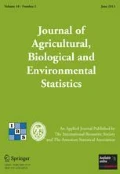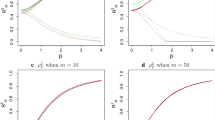Abstract
We address the question of identifying the relative importance of covariates for model response, a form of sensitivity analysis. Relative importance is typically implemented as part of the model building procedure, e.g., forward variable selection or backward elimination. Here, we take a different perspective. We assume a model with multiple covariates and multivariate response has been selected and formulate criteria to assess covariate importance. Hence, with regard to covariates, our approach is joint, post model fitting, rather than conditional or sequential model creation. The noteworthy challenge we accommodate is the handling of multivariate response where individual regressions may give differing, perhaps conflicting, relative importances. In addition, we recognize that, according to the model specification, importance/sensitivity to covariates may be a global or a local issue. For models with multivariate response, we provide a criterion that (i) produces one sensitivity coefficient for each covariate, (ii) takes into account the model specification of uncertainty, and (iii) is based only on the model parameters but does not require a distribution on the covariates. However, with a prior on the covariates, in special cases, we show that comparison of covariates using this criterion gives the same results as comparison of marginal variances of the inverse predictive distributions of the covariates. We illustrate with an application examining sensitivity of tree abundance to climate.
Supplementary materials accompanying this paper appear on-line.









Similar content being viewed by others
References
Azen, R., and Budescu, D. V. (2003), “The dominance analysis approach for comparing predictors in multiple regression,” Psychological methods, 8(2), 129–148.
——— (2006), “Comparing Predictors in Multivariate Regression Models: An Extension of DominanceAnalysis,” Journal of Educational and Behavioral Statistics, 31(2), 157–180.
Bechtold, W. A., and Patterson, P. L. (2005), The Enhanced Forest Inventory and Analysis Program—National Sampling Design and Estimation Procedures, General technical report, SRS-80 edn, USDA Forest Service, Southern Research Station, Asheville, NC.
Budescu, D. V. (1993), “Dominance analysis—a new approach to the problem or relative importance of predictors in multiple-regression,”Psychological Bulletin, 114(3), 542–551.
Campolongo, F., Cariboni, J., and Saltelli, A. (2007), “An effective screening design for sensitivity analysis of large models,” Environmental Modelling and Software, 22, 1509–1518.
Cariboni, J., Gatelli, D., Liska, R., and Saltelli, A. (2007), “The role of sensitivity analysis in ecological modelling,” Ecological Modelling, 203, 167–182.
Chao, Y.-C. E., Zhao, Y., Kupper, L. L., and Nylander-French, L. A. (2008), “Quantifying the relative importance of predictors in multiple linear regression analyses for public health studies,” J Occup Environ Hyg, 5(8), 519–529.
Chib, S., and Greenberg, E. (1998) , “Analysis of Multivariate Probit Models,” Biometrika, 85(2), 347–361.
Clark, J., Bell, D., Chu, C., Courbaud, B., Dietze, M., Hersh, M., HilleRisLambers, J., Ibáñez, I., LaDeau, S., McMahon, S. et al. (2010), “High-dimensional coexistence based on individual variation: a synthesis of evidence,” Ecological Monographs, 80(4), 569–608.
Clark, J. S., Bell, D. M., Hersh, M. H., and Nichols, L. (2011), “Climate change vulnerability of forest biodiversity: climate and competition tracking of demographic rates,” Global Change Biology, 17, 1834–1849.
Clark, J. S., Bell, D. M., Kwit, M., Powell, A., and Zhu, K. (2013), “Dynamic inverse prediction and sensitivity analysis with high-dimensional responses: Application to climate-change vulnerability of biodiversity,” Journal of Agricultural, Biological, and Environmental Statistics, p. Accepted.
Confalonieri, R., Bellocchi, G., Bregaglio, S., Donatelli, M., and Acutis, M. (2010), “Comparison of sensitivity analysis techniques: A case study with the rice model WARM,” Ecological Modelling, 221, 1897–1906.
Cook, R. D. (1993), “Exploring Partial Residual Plots,” Techometrics, 35(4), 351–362.
Daly, C., Halbleib, M., Smith, J. I., Gibson, W. P., Doggett, M. K., Taylor, G. H., Curtis, J., and Pasteris, P. P. (2008), “Physiographically sensitive mapping of climatological temperature and precipitation across the conterminous United States,” International Journal of Climatology, 28(15), 2031–2064.
Darlington, R. B. (1968), “Multiple regression in psychological research and practice,” Psychological Bulletin, 69(3), 161–182.
Ebrahimi, N., Soofi, E. S., and Soyer, R. (2010), “Information Measures in Perspective,” International Statistical Review, 78(3), 383–412.
Fieberg, J., and Jenkins, K. J. (2005), “Assessing uncertainty in ecological systems using global sensitivity analyses: a case example of simulated wolf reintroduction effects on elk,” Ecological Modelling, 187, 259–280.
Gelman, A. (2004), “Parameterization and Bayesian Modeling,” Journal of the American Statistical Association, 99(466), 537–545.
Gilman, S., Wethey, D., and Helmuth, B. (2006) , “Variation inthe sensitivity of organismal body temperature to climate changeover local and geographic scales,” Proceedings of theNational Academy of Sciences of the United States of America,103(25), 9560–9565.
Ginot, V., Gaba, S., Beaudouin, R., Aries, F., and Monod, H. (2006), “Combined use of local and ANOVA-based global sensitivity analyses for the investigation of a stochastic dynamic model: Application to the case study of an individual-based model of a fish population,” Ecological modelling, 193(3–4), 479–491.
Gneiting, T., and Raftery, A. E. (2007), “Strictly Proper Scoring Rules, Prediction, and Estimation,” Journal of theAmerican Statistical Association, 102(477), 359–378.
Goldstein, W. M. (1990), “Judgments of Relative Importance in Decision Making: Global vs Local Interpretations of Subjective Weight,” Organizational Behavior and Human Decision Preocesses, 47, 313–336.
Green, P. E., Carroll, J. D., and DeSarbo, W. S. (1978), “A New Measure of Predictor Variable Importance in Multiple Regression,” Journal of Marketing Research, 15(3), 365–360.
Hamby, D. M. (1994), “A review of techniques for parameter sensitivity analysis of environmental models,” Environmental Monitoring and Assessment, 32, 135–154.
Homma, T., and Saltelli, A. (1996), “Importance measures in global sensitivity analysis of nonlinear models,”Reliability Engineering and System Safety, 52(1), 1–17.
Johnson, J., and LeBreton, J. (2004), “History and use of relative importance indices in organizational research,” Organizational Research Methods, 7(3), 238–257.
Johnson, J. W. (2000), “A Heuristic Method for Estimating the Relative Weight of Predictor Variables in Multiple Regression,”Multivariate Behavioral Research, 35(1), 1–19.
Kruskal, W., and Majors, R. (1989), “Concepts of Relative Importance in Recent Scientific Literature,” The AmericanStatistician, 43(1), 2–6.
LeBreton, J. M., and Tonidandel, S. (2008), “Multivariate Relative Importance: Extending Relative Weight Analysis to Multivariate Criterion Spaces,” Journal of Applied Psychology,93(2), 329–345.
Nathans, L. L., Oswald, F. L., and Nimon, K. (2012), “Interpreting Multiple Linear Regression: A Guidebook of Variable Importance,” Practical Assessment, Research & Evaluation, 17(9), 1–19.
Retzer, J., Soofi, E., and Soyer, R. (2009), “Information importance of predictors: Concept, measures, Bayesian inference, and applications,” Computational Statistics and Data Analysis, 53, 2363–2377.
Smith, W. B., Miles, P. D., Perry, C. H., and Pugh, S. A. (2009), Forest resources of the United States, 2007, General technical report, WO-78 edn., USDA Forest Service, Washington Office, Washington, DC.
Strobl, C., Boulesteix, A.-L., Kneib, T., Augustin, T., and Zeileis, A. (2008), “Conditional variable importance for random forests,” BMC Bioinformatics, 9, 307.
Thomas, D. R., Hughes, E., and Zumbo, B. D. (1998), “On Variable Importance in Linear Regression,” Social Indicators Research, 45(1/3), 253–275.
Yen, J. D. L., Thomson, J. R., Vesk, P. A., and Nally, R. M. (2011), “To what are woodland birds responding? Inference on relative importance of in-site habitat variables using several ensemble habitat modelling techniques,”Ecography, 34, 946–954.
Zhu, J., Eickhoff, J. C., and Yan, P. (2005), “Generalized linear latent variable models for repeated measures of spatially correlated multivariate data,” Biometrics, 61(3), 674–83.
Acknowledgments
The authors thank Jim Clark for motivating this work and for useful conversations, Kai Zhu for help in preparing the FIA dataset which we analyzed and anonymous Associate Editor and Reviewers for helpful comments on earlier versions of this paper. The work of the authors was supported in part by NSF CMG 0934595 and NSF CDI 0940671.
Author information
Authors and Affiliations
Corresponding author
Electronic supplementary material
Below is the link to the electronic supplementary material.
Appendices
Appendix 1: Proof of Theorem 2.2
The model in (3) and (4) implies that the joint distribution of \(\mathbf {Y}\) and \(\mathbf {X}\) is Gaussian and therefore the conditional distribution \([ \mathbf {X}|\mathbf {Y},\theta ]\) is also Gaussian with covariance matrix
If follows that
Appendix 2: Proof of Remark 2.3
Theorem 6.1
Let
Let \(\tilde{\mathbf {X}}\) be the standardized \(\mathbf {X}\), i.e., \(\tilde{\mathbf {X}} = D^{-1} \mathbf {X}\) where \( D = \mathrm{diag}(\sigma _{X_1}, \ldots , \sigma _{X_p})\) and \(\sigma _{X_j}\) is the marginal standard deviation of \(X_j\). Let
be the corresponding relationship between \(\mathbf {Y}\) and \(\tilde{\mathbf {X}}\) where \(R\) is a correlation matrix. Then
Proof
It follows from (21) that \(\mathbf {Y}\) and \(\mathbf {X}\) are jointly normal and we denote the joint covariance matrix as \(\Sigma = \left( \begin{array}{ll} \Sigma _{YY} &{} \Sigma _{YX} \\ \Sigma _{XY} &{} \Sigma _{XX} \end{array} \right) \) where \(\Sigma _{YY}\) and \(\Sigma _{YX}\) can be found from \(B\), \(\Sigma _{Y|X}\) and \(\Sigma _{XX}\). Also, the joint distribution of \(\mathbf {Y}\) and \(\tilde{\mathbf {X}}\) is normal with covariance matrix \(\tilde{\Sigma } = \left( \begin{array}{ll} \Sigma _{YY} &{} \Sigma _{YX} D^{-1} \\ D^{-1}\Sigma _{XY} &{} D^{-1} \Sigma _{XX} D^{-1} \end{array} \right) \). Furthermore, \(\tilde{B}\) and \(B\) can be written as \(B = \Sigma _{YX} \Sigma _{XX}^{-1}\) and \(\tilde{B} = \tilde{\Sigma }_{YX} R^{-1}\), where \(R=D^{-1} \Sigma _{XX} D^{-1} \). Finally, note that \(\tilde{\Sigma }_{Y|X} = \Sigma _{Y|X}\). Putting all this together we get
Proof of Remark 2.3
The first line follows from Theorem 2.1 and the second line follows from Theorem 6.1.
Appendix 3: Theorem for \(p>2\)
Theorem 7.1
Let \(\mathbf {Y}\) and \(\mathbf {X}\) be \(r\) and \(p\) dimensional random vectors where \(p>2\). Let
For integers \(k\), \(k^\prime \), let \(\mathbf {X}_s = (X_k,X_{k^\prime })^\mathrm{T}\) and let \(\mathbf {X}_{-s}\) be a vector of the remaining elements of \(\mathbf {X}\). Also, assume that the marginal variances of \(X_k\) and \(X_{k^\prime }\) are equal, i.e., \( \Sigma _{X_sX_s} = \left( \begin{array}{ll} \sigma ^2 &{} \sigma _{12} \\ \sigma _{12} &{} \sigma ^2 \end{array} \right) \) and that the parameters \(\theta = ({\varvec{\mu }}_{Y|X}, {\varvec{\mu }}_X, B, \Sigma _{Y|X}, \Sigma _{XX})\) are known. Then
where \(\mathbf {b}_k\) is the \(k\)th column of \(B\) and \(B_{-s}\) is \(B\) without the \(k\)th and \(k^\prime \)th columns.
Proof
Let \(\mathbf {U} = \mathbf {Y} - B_{-s} \mathbf {X}_{-s}\). Then
where \(B_s = \begin{bmatrix} \mathbf {b}_k&\mathbf {b}_{k^\prime } \end{bmatrix}\). By Theorem 2.1, it then follows that
To see why (25) holds we note that (24) implies that the joint distribution of \(\mathbf {Y}\), \(\mathbf {X}_s\), and \(\mathbf {X}_{-s}\) is normal. Hence, the joint distribution of \(\mathbf {U}\) and \(\mathbf {X}_s\) is also normal since \((\mathbf {U}^\mathrm{T},\mathbf {X}^\mathrm{T}_s)^\mathrm{T}\) is a linear transformation of \((\mathbf {Y}^\mathrm{T},\mathbf {X}^\mathrm{T}_s, \mathbf {X}^\mathrm{T}_{-s})^\mathrm{T}\). Therefore, the conditional distribution of \(\mathbf {U}|\mathbf {X}_s\) is normal. The mean vector and covariance matrix can be found via iterative expectations:
Rights and permissions
About this article
Cite this article
Brynjarsdóttir, J., Gelfand, A.E. On Covariate Importance for Regression Models with Multivariate Response. JABES 19, 479–500 (2014). https://doi.org/10.1007/s13253-014-0187-9
Received:
Accepted:
Published:
Issue Date:
DOI: https://doi.org/10.1007/s13253-014-0187-9




